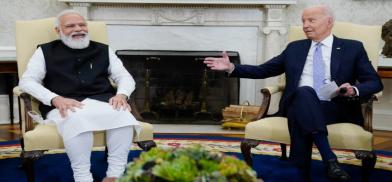Modi in Tokyo for Quad Summit, to meet Biden and new Australian PM
A review of Quad initiatives is one of the key agendas for the four world leaders, an Indian government statement quoted the prime minister as saying before his departure. The grouping includes the world’s oldest and largest democracies — Japan, India, Australia and US — and represents a combined GDP of $34 trillion, or 40 per cent of the global total.

Prime Minister Narendra Modi arrived in Tokyo early Monday to attend the second in-person Quad leaders’ summit that will include US President Joe Biden, Japanese Prime Minister Fumio Kishida and newly elected Australian Prime Minister Anthony Albanese, who will attend the summit just a day after his swearing-in. Biden is already in Tokyo as part of his first visit to Asia, with an earlier stopover in Seoul, South Korea.
Tweeting early morning pictures, Modi said: “Landed in Tokyo. Will be taking part in various programmes during this visit including the Quad Summit, meeting fellow Quad leaders, interacting with Japanese business leaders and the vibrant Indian diaspora.”
A review of Quad initiatives is one of the key agendas for the four world leaders, an Indian government statement quoted the prime minister as saying before his departure. The grouping includes the world’s oldest and largest democracies — Japan, India, Australia and US — and represents a combined GDP of $34 trillion, or 40 per cent of the global total.
Short for the Quadrilateral Security Dialogue, it’s an informal grouping that first joined hands for the purposes of coordinating relief work in the wake of the 2004 Indian Ocean tsunami. There was an attempt for a more accentuated coming together in 2007, but the moves were abandoned reportedly over protests from China. Now, it is the spectre of China that is said to have brought the four countries together, according to News18.
However, the Quad is not structured like a typical multilateral organisation and lacks a secretariat and any permanent decision-making body. Instead of creating policy along the lines of the European Union or United Nations, the Quad has focused on expanding existing agreements between member countries and highlighting their shared values. Additionally, unlike NATO, the Quad does not include provisions for collective defence, instead choosing to conduct joint military exercises as a show of unity and diplomatic cohesion.
In 2020, the trilateral India-US-Japan Malabar naval exercises expanded to include Australia, marking the first official grouping of the Quad since its resurgence in 2017 and the first joint military exercises among the four countries in over a decade.
The Quad leaders would like to say, and believe, that the grouping is not all about China, but the one thing that is clearly common to all the four Quad partners is their strained ties with Beijing, which calls Quad "Asian NATO", the News18 brief said.
The pursuit of a free and open Indo-Pacific by India and Japan would put the two countries in a contested space with China. Japan is locked in disputes with China over the Senkaku, or Diaoyu, Islands in the East China Sea that both countries claim as their own while India and China have been at loggerheads over differing perceptions of their shared border. Further, China has been trying to expand its influence in the Indian Ocean region, where India is the pre-eminent presence, by cosying up to the likes of Sri Lanka and the Maldives.
Ties between the US and China hit a low during the tenure of Biden’s predecessor Donald Trump and saw the two countries engage in a tariff war. Moreover, with its exit from Afghanistan, the US is now working on an Asia-Pacific pivot which, experts say, shows that containing China is the next big goal for Washington.
While Australia has been more circumspect about actions that would rile China, its biggest trade partner, it has nonetheless seen ties become strained following its call for a probe into the Wuhan lab leak theory behind the novel coronavirus pandemic. That saw China slap sanctions on the country earlier this year. Which in turn has seen Australia turn more assertive; after more than 10 years since it first took part in the Malabar naval exercise that was started by the US and India and has regularly featured Japan, it joined in the drill last year.
The Chinese military and the Quad members have crossed paths in recent times. While Indian soldiers were involved in clashes with Chinese troops at Galwan on the Line of Actual Control (LAC) with China last year, the US and Australia had deployed warships in the South China Sea earlier this year following a standoff involving a Chinese and Malaysian vessel.
According to the Spirit of the Quad, the group’s primary objectives include maritime security, combating the Covid-19 crisis, especially vis-à-vis vaccine diplomacy, addressing the risks of climate change, creating an ecosystem for investment in the region and boosting technological innovation. Quad members have also indicated a willingness to expand the partnership through a so-called Quad Plus that would include South Korea, New Zealand, and Vietnam amongst others.













Post a Comment